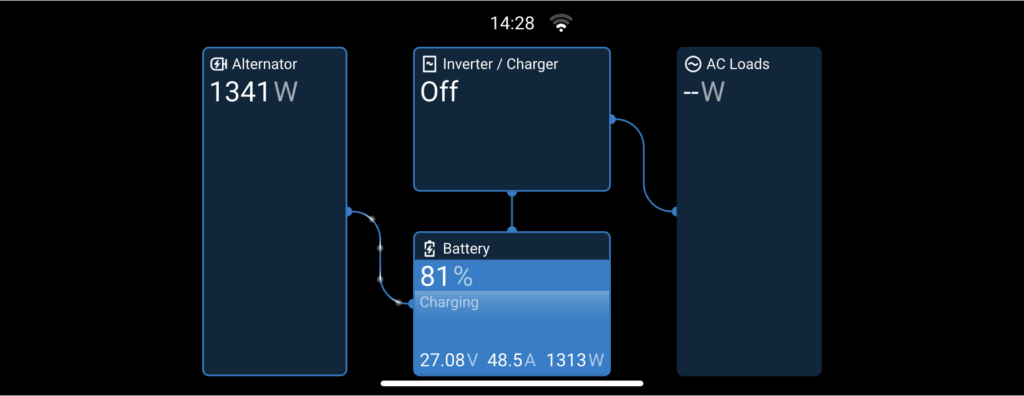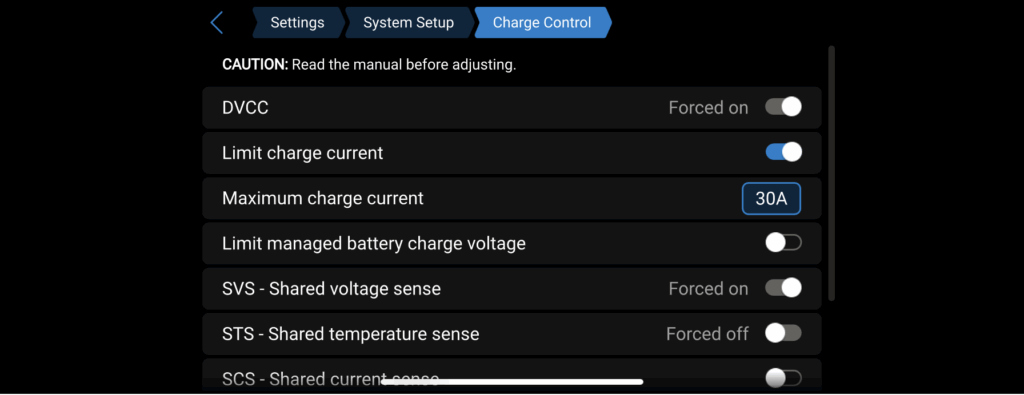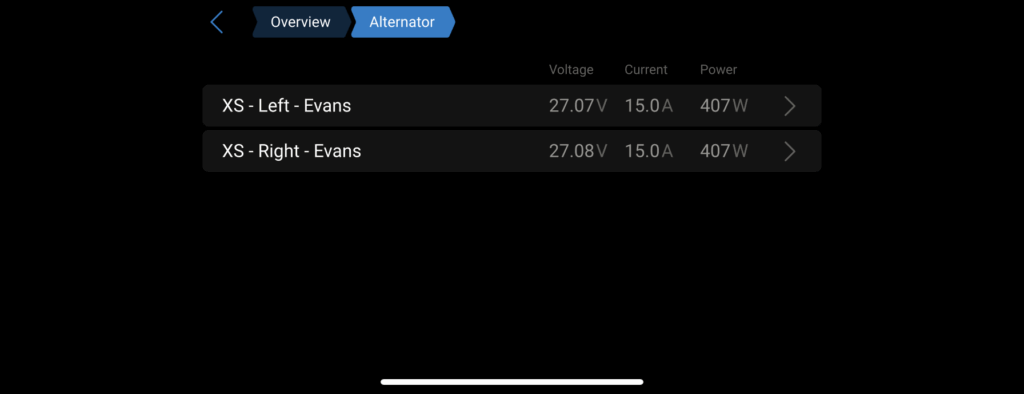Series: All Victron RV Electrical
This series covers our build of an all Victron electrical system. Take what is helpful and leave the rest—build your system for your own needs. Cheers!
Note: We are not sponsored by Victron, but we are Amazon and Tnutz affiliates.
Part 4: Wiring and Configuration
Part 5: Orion XS 1400 – Concept
Part 6: Orion XS 1400 – Design
Part 7: Orion XS 1400 – Installation
Introduction
In the last post I covered wiring and configuration that led to a working power system. However, it did not include the ability to charge from our truck’s 377A dual alternators, which I spoke about in my means of replenishment discussion. We move camp frequently, therefore can charge frequently as we drive.
In this post—nearly one year later—I talk about why the release of the Orion XS 1400 DC-DC charger was worth the wait. I end with a brief discussion of requirements, or what we hoped to achieve by adding these chargers to our system.
Why Install a DC-DC Charger?
On our travel trailer we installed a lithium power system that has worked well for our needs. Details of that install are covered in this post. It has 600W of solar installed on the roof and we use a generator as backup. Charging from our alternators is a bonus.
The current draw from our alternators on that system is about 10 amps and we don’t do anything special to get it—factory 12 AWG trailer wiring manages that without a problem. At a roundtrip distance of 60 feet or more voltage drop is sufficient to ensure the trailer’s house batteries draw little charging current.
However, to draw significantly more charge current is a different beast. Much larger cable is needed to handle high current safely and minimize voltage drop. Also, to reliably charge lithium batteries from smart alternators, where voltages can vary between 12.5V and 15V, additional circuitry is needed. And, because lithium batteries have a low internal resistance and charge profile that places unique demands on an alternator—bulk charging up to 80 to 90% SOC or more—care must be taken to avoid excessive heat in an over-stressed alternator.
This is where DC-DC chargers shine because they
- boost output voltage when alternator voltage dips,
- limit current draw from a large bank to avoid alternator overheating,
- provide isolation between starter and house batteries,
- support lithium charge profiles.
Why Wait for the Orion XS 1400?
The wait sucked. Victron released the 12V version of the Orion XS in early 2024, but ours is a 24V system. We completed the first phase of our power system in July 2024 and the expected release of the 24V version was late 2024. Then the release kept getting pushed. We were finally able to order two Orion XS 1400 units in April 2025, arriving in mid-August.
This resulted in a year—that we travelled half the time—of lugging around and listening to our generator. Not ideal, but worth it to eventually install the chargers that are better than all the rest.

There were several popular DC-DC chargers available that support 24V systems, including the older Orion-Tr Smart 12/24V DC-DC charger. However, none of them have the awesome features of the Orion XS 1400.
Flexibility, Power, and Efficiency
The Orion XS 1400 supports any combination of 12/24V inputs and outputs, alleviating the need to buy a particular 12-12, 12-24, 24-12, or 24-24 volt unit. It offers a wide input voltage range from 9V to 35V, with a whopping 1400W power rating—note 1400 in the name—for the 24-24 volt combination.
Victron knocked it out of the park with this design, resulting in a 700/1400W charger that is significantly smaller and lighter than the Orion-Tr Smart 360W unit. They did this by introducing ultra-efficient circuit board components, increasing efficiency by about 10% to a whopping 98.5%!
We hoped to achieve in the neighborhood of 1200W of charge power. This meant installing two Orion XS 1400s, each rated for 700W with 14V nominal voltage at the inputs. If we had gone with four Orion-Tr Smart units (4 * 360W = 1440W) we would have achieved a similar outcome—at greater cost—with less charging watts due to greater inefficiency:
- 0.88 (Orion-Tr Smart efficiency) * 1440W = 1267W vs.
- 0.985 (Orion XS efficiency) * 1400W = 1379W.
And, space is limited in an RV! We would have struggled to find room in our electrical cabinet for four much larger units and associated wiring.
The image below shows the combined output of our Orion XS chargers. Typically, power output starts in the 1340’s and drops a little as the system heats up. It’s less than the calculated 1379W above, primarily due to the effects of temperature and voltage drop.

Full Integration and Wireless Configurability
With the introduction of the Orion XS, a hard-wired connection to a Cerbo/Ekrano GX is now possible with a VE.Direct cable, allowing for Distributed Voltage and Current Control (DVCC) and VRM remote monitoring. DVCC allows you to control multiple charge sources—inverter/chargers, solar charge controllers, and Orion XS units—through a single interface.
For example, on my phone over Wi-Fi I can set maximum charge current in a single setting, which controls both Orion XS units as we are driving down the road. Suppose it’s hot out and you want to back off on charge current. If you set maximum charge current to 30A, both units instantly back off to 15A each.


Also, DVCC eliminates the need for additional control wiring. I had planned to wire the remote switches on the Orion units to the Allow To Charge (ATC) pin on our Smart Lynx BMS, to prevent things like low temperature charge and overcharging; however, this is unnecessary since DVCC already performs these functions.
Even if your system does not include a GX device and DVCC is not an option, VictronConnect configuration over Bluetooth is another key area where the Orion XS is improved over the Orion-Tr Smart. For the latter you can set battery type, charger function, and adjust voltages; however, you cannot adjust input or output current levels. Now you can with the Orion XS.
Engine Shutdown Detection
Competitor units rely solely on voltage sensing for shutdown detection, but still recommend a hardwired ignition connection to prevent starter battery discharge. However, for both Orion-Tr Smart and the Orion XS, hardwired protection is merely optional.
Victron takes voltage sensing a step further by accounting for voltage variations associated with modern smart alternators. Smart alternators with regenerative braking can result in large voltage variations, typically 12.5V to 15V. Victron incorporates voltage levels, delays, and on/off hysteresis logic configurable in settings to account for these variations.
Requirements
- [Requirement] The DC-DC charging system will be sufficient to restore energy used over the course of normal travel.
We want to ditch the generator, so this new charging system must act as a replacement. With respect to normal travel, the implication is we need to drive at regular intervals to stay charged. This is not an issue. Most days we travel to a trailhead for a hike, but occasionally we have a down day where we stay at camp for two nights without moving. Luckily our house battery is sufficiently sized to go several days without a charge.
I planned for the possibility of idle charging, charging from the alternators without driving. However, this should be minimized due to the truck’s limited ability to dissipate heat when not moving.
- [Goal] The DC-DC charging system will not place undue heat stress on the truck’s alternators and associated components.
This is a goal rather than a requirement because implementation of a system that automates heat management is not feasible. It helps to size and configure charging components with heat in mind, but this alone is not sufficient. It will depend primarily on how we use the system in various conditions.
Next Up
In the next post I cover design associated with charging from our alternators.
Parts List
Here is a list of items we purchased to build our system.
You can navigate the Excel spreadsheet below directly or download the file through the download button on the bottom right.
We are Amazon affiliates and appreciate your purchases through the provided links.
We are also Tnutz affiliates. They offer the lowest prices on the web for aluminum extrusions, brackets, and much else. Before ordering through Tnutz check out this page to learn how to save on shipping.
Thank you!